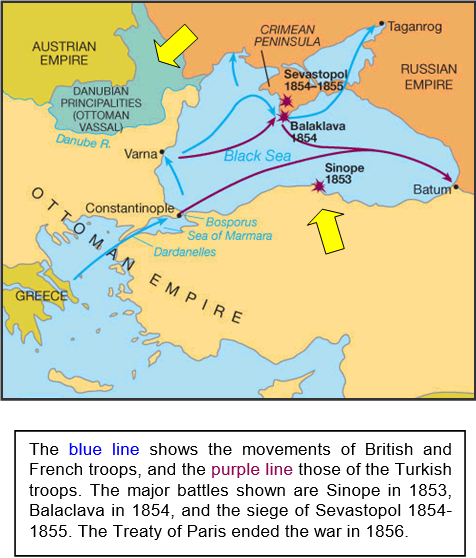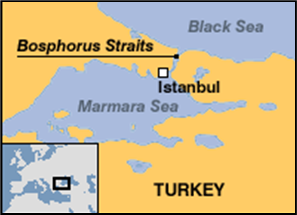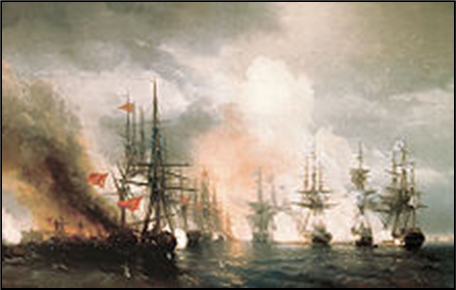


xxxxxThe basic cause of the Crimean War was the continuing decline of Turkey and its Ottoman Empire, and the fear by Austria, Britain and France that Russia would use this as an opportunity to increase its power in the Black Sea and the Balkans. As we have seen, Catherine the Great had gained a foothold on the north coast of the Black Sea in 1774 (G3a), and taken over the Crimea nine years later. In the Balkans, the Treaty of Adrianople in 1829 had given the Russians some control over Moldavia and Walachia, and in 1833 the Treaty of Unkiar-
THE CRIMEAN WAR 1853 -
Acknowledgements
Map (Crimea): detail from www.allrussias.com/tsarist_russia/Alex_II. Map (Bosphorus): from www.simplyistanbul.org/istanbul/map-
 xxxxxThe root cause of the Crimean War was the continuing decline of the Muslim state of Turkey, the ineffective ruler of a vast but shrinking Ottoman Empire which, at one time, had stretched across large parts of Africa, Asia and Europe. As the “sick man of Europe” went into decline, and his subject lands began to totter, a number of European countries -
xxxxxThe root cause of the Crimean War was the continuing decline of the Muslim state of Turkey, the ineffective ruler of a vast but shrinking Ottoman Empire which, at one time, had stretched across large parts of Africa, Asia and Europe. As the “sick man of Europe” went into decline, and his subject lands began to totter, a number of European countries -
 xxxxxThere had then followed a steady Russian advance into the Balkans. With the overthrow of Turkish authority in Greece, the Treaty of Adrianople of 1829 had given the Russians a commanding voice in the Turkish principalities of Moldavia and Walachia (in today’s Romania), as well as access to the Mediterranean via the Turkish (Bosphorus) Straits (illustrated left). Thenxfour years later came the Treaty of Unkiar-
xxxxxThere had then followed a steady Russian advance into the Balkans. With the overthrow of Turkish authority in Greece, the Treaty of Adrianople of 1829 had given the Russians a commanding voice in the Turkish principalities of Moldavia and Walachia (in today’s Romania), as well as access to the Mediterranean via the Turkish (Bosphorus) Straits (illustrated left). Thenxfour years later came the Treaty of Unkiar-
xxxxxBut this diplomatic solution only served to postpone a conflict in the making. In 1852 Tsar Nicholas, believing that Western Europe would not wish to be openly embroiled in Balkan affairs, and, further, that he could depend on the friendship of his neighbour, Austria, latched on to a religious squabble in Turkish-
 xxxxxIt was to be a conflict noted for its heavy casualties and military and logistic incompetence, in which the allied powers of Britain, France, Turkey and Sardinia eventually managed to defeat Russia and, for a time, check its ambitions in the Balkans and Black Sea areas. The first major engagement was the Battle of Sinope, which took place in November 1853. It was then that the Russian navy made a surprise attack upon Sinope, the Turkish seaport on the south coast of the Black Sea (arrowed on large map above). Much of the city and harbour installations were badly damaged, and the Ottoman fleet was completely destroyed (illustrated). Turkish casualties were put at 4,000, and it was reported that many were shot by Russian sailors as they floundered in the water.
xxxxxIt was to be a conflict noted for its heavy casualties and military and logistic incompetence, in which the allied powers of Britain, France, Turkey and Sardinia eventually managed to defeat Russia and, for a time, check its ambitions in the Balkans and Black Sea areas. The first major engagement was the Battle of Sinope, which took place in November 1853. It was then that the Russian navy made a surprise attack upon Sinope, the Turkish seaport on the south coast of the Black Sea (arrowed on large map above). Much of the city and harbour installations were badly damaged, and the Ottoman fleet was completely destroyed (illustrated). Turkish casualties were put at 4,000, and it was reported that many were shot by Russian sailors as they floundered in the water.
xxxxxThis battle, noted for its effective use of the shell gun in naval warfare, was regarded as a massacre in Britain and France, and led to an enormous public outcry and a demand for war. For its part, the British government had no brief for Turkey, but saw the need to keep the power of Russia in check. Britain and France sent fleets to the Black Sea, and, as we shall see, both countries declared their support for Turkey in March 1854, a year that was to witness the Battles of the River Alma, Balaclava and Inkerman.
Including:
The Battle of Sinope

Va-


